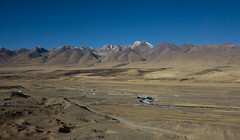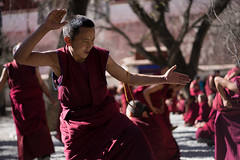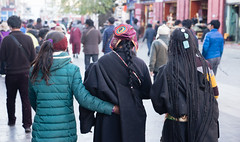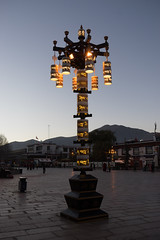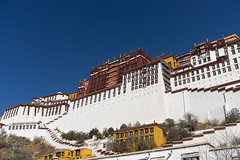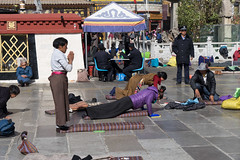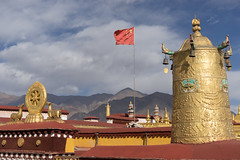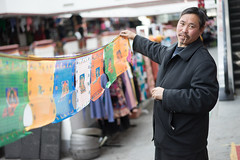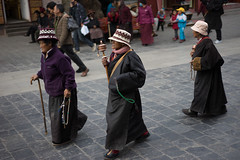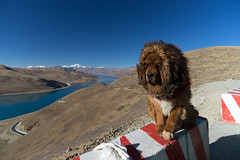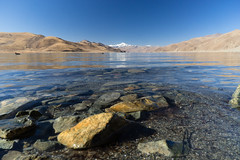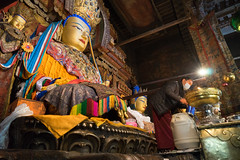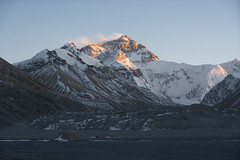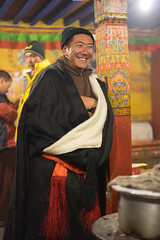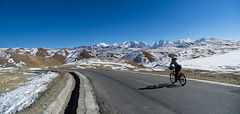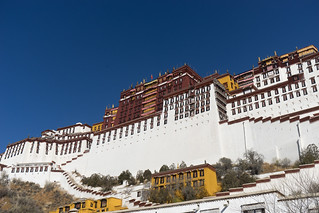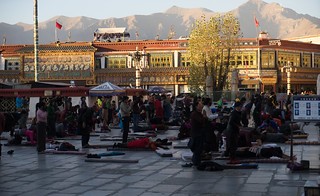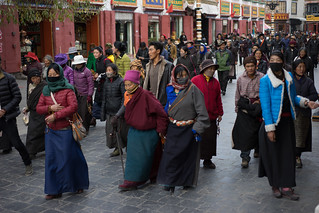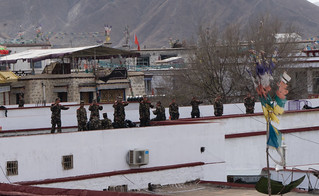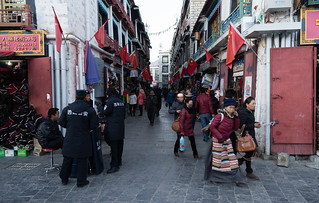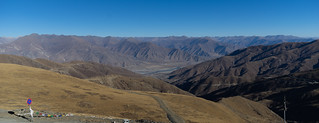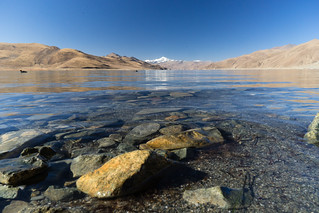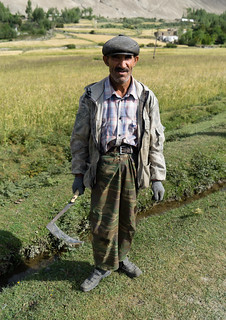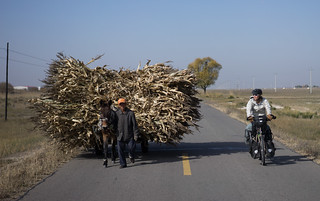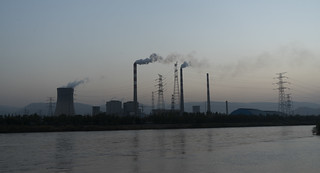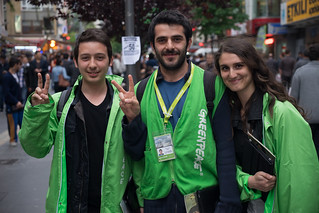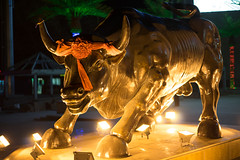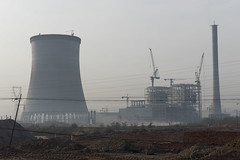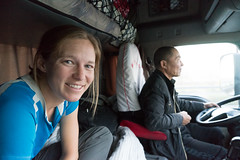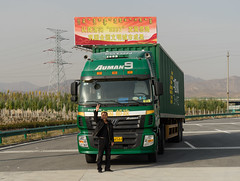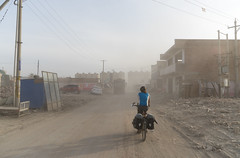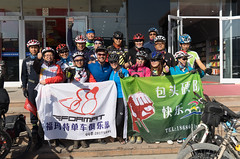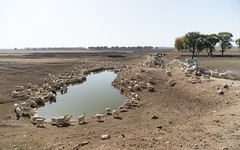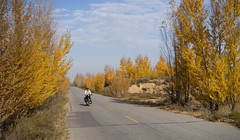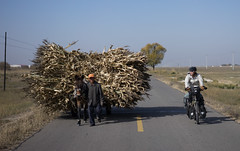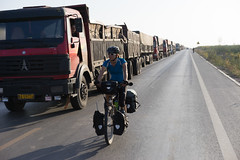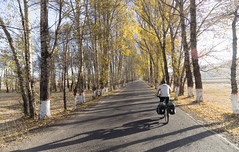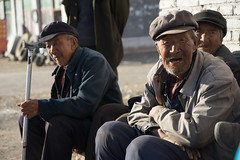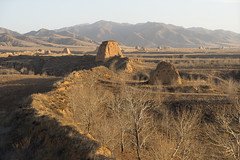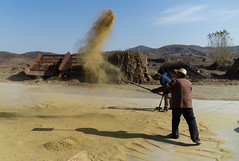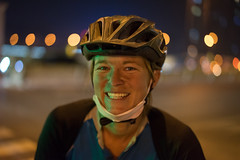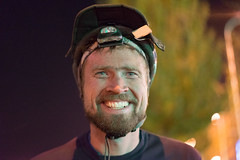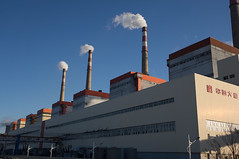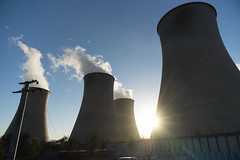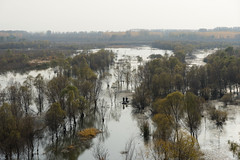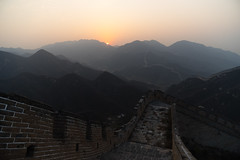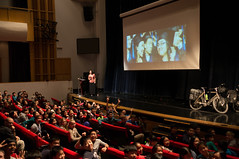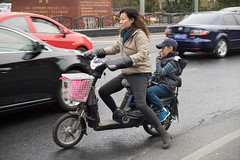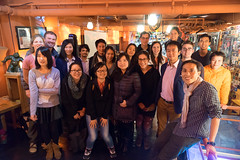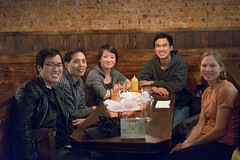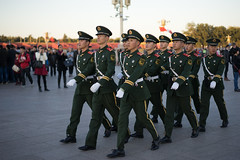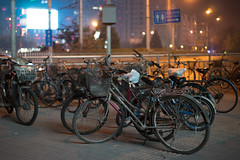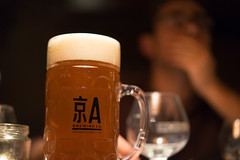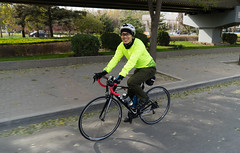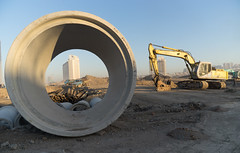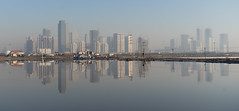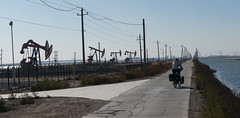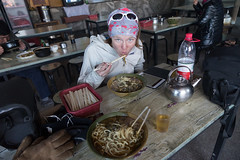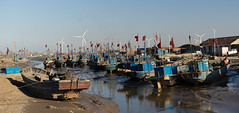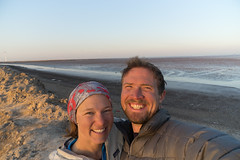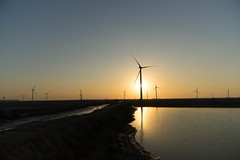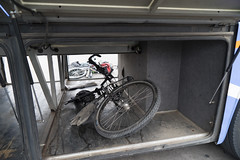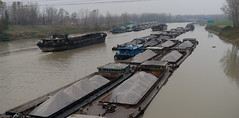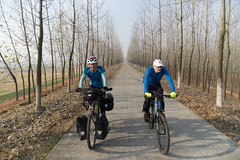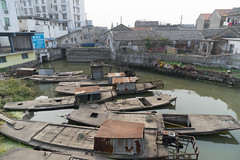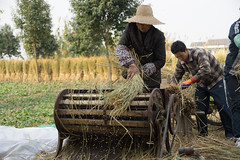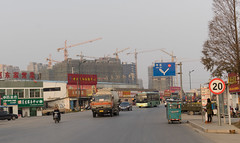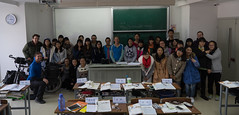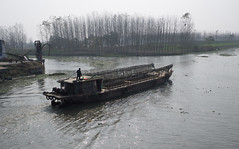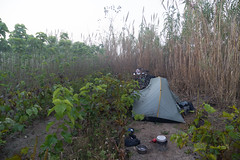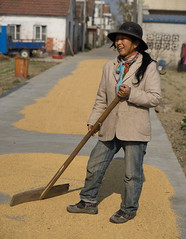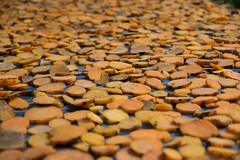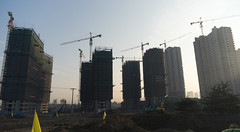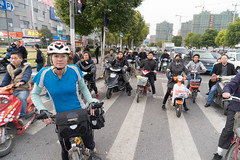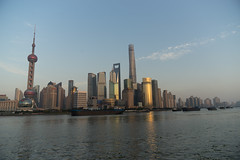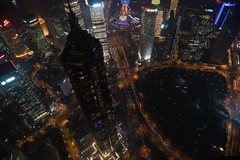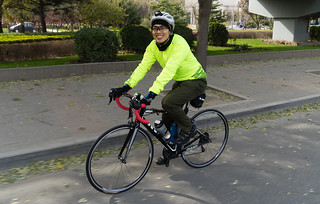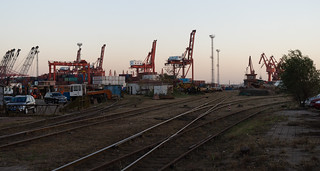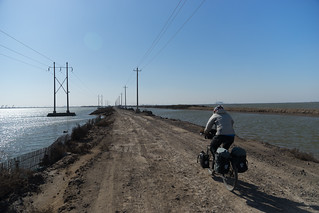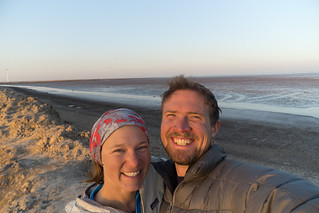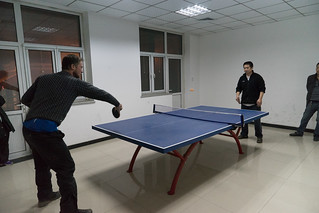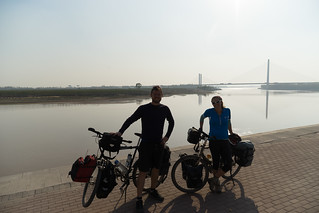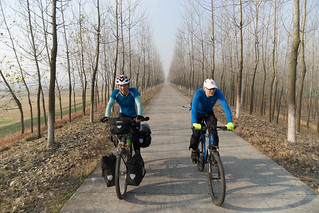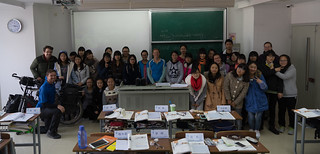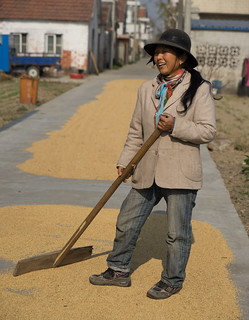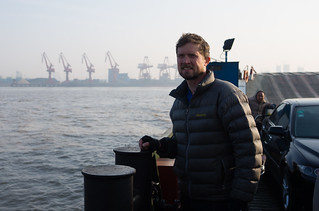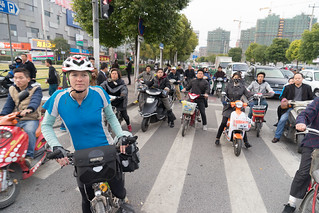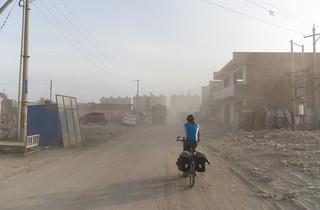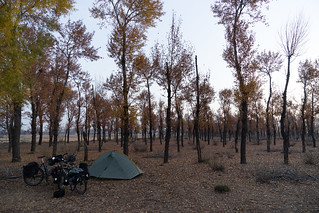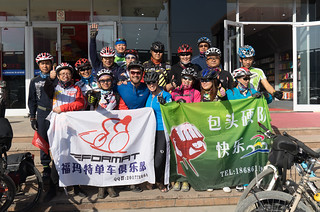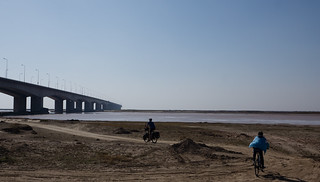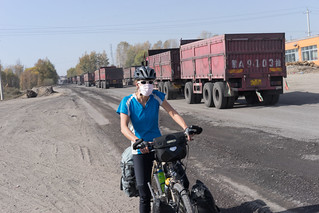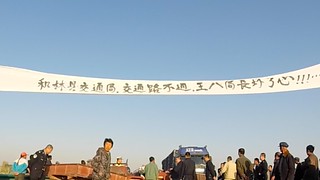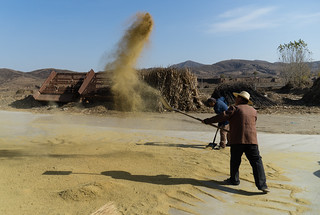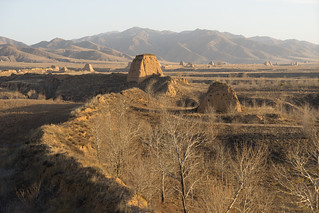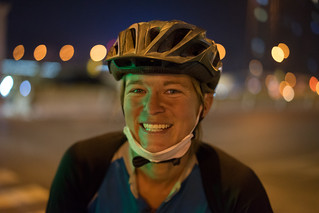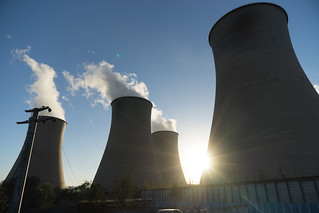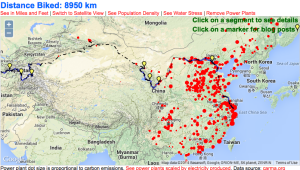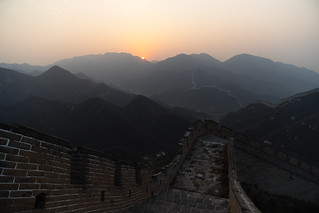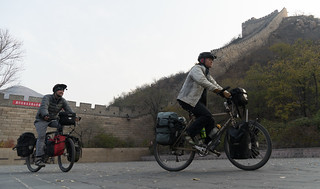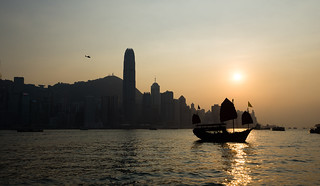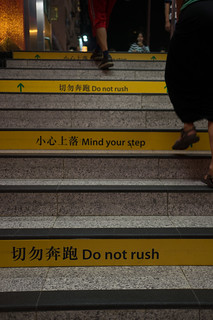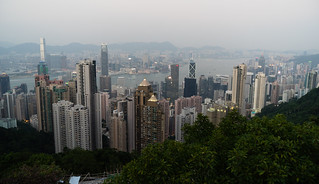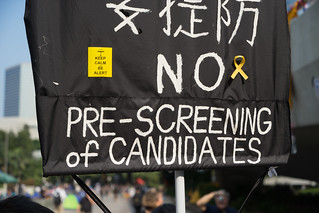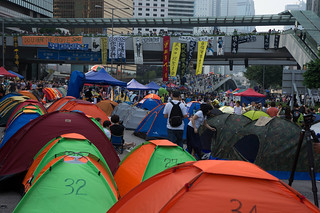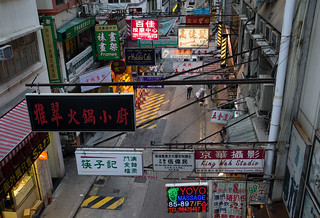Below are our best photos from the Tibet Autonomous Region (TAR). To see all 180 (!) of our photos from the TAR, click here.
Archive for the ‘China’ Category
Tibet Autonomous Region – Photos
Saturday, December 13th, 2014The Tibetan Autonomous Region — Bikes on a Train and Bus
Friday, December 12th, 2014We ended our two and a half month journey across Chinese territory with a train ride and then bus tour across the Tibetan Autonomous Region (TAR), the province of China that occupies the southwest portion of the Tibetan plateau and butts against Nepal. We had originally planned to bike across this high altitude region (which has an average elevation of around 15,000 feet), but the Chinese government forbids foreigners to travel independently. If we were to bike it we’d have to pay a jeep to follow us, which is not only prohibitively expensive, but also against the ethos of ride for climate. So we took a train to Lhasa and then joined a bus tour with 10 other young foreign travelers who had also forked over the roughly $1,000 USD per person to visit this semi-forbidden land.
The tour began with two days in Lhasa, where our guide led us around monasteries, the Potala Palace, and the city’s holiest temple. I was especially impressed by the Potala Palace, the former home of the Dali Lama (before he fled in 1959), which was built before the American Revolution and, at 13 stories, is the tallest ancient palace in the world. Few buildings in Lhasa rise higher than two stories. But what was even more impressive than the palace were the pilgrims. In November, there are few foreign or Chinese tourists in Lhasa, but many Tibetan pilgrims (many people in China told us that it was far too cold for us to visit Tibet at this time of year — in general, we found Chinese people unnaturally afraid of the cold, and they always asked us if we were cold if exposed any skin while biking). Apparently, after the fall harvest is when most Tibetans make their pilgrimages to holy sites such as Lhasa (and the Tibetans are far less afraid of the cold).
The holy sites were full of Tibetan pilgrims, and in the tight hallways and rooms of the holy buildings they would often elbow their way around us to stare with wonder at the shrines. In front of the city’s main temple, many pilgrims, young and old, prostrated themselves before the temple, over and over. This involves bringing the hands together in prayer in front of the face, then lying face down on the ground, standing up, and then repeating the motion. To count how many prostrations they do, many pilgrims use prayer beads — every time they lie down on the ground they move a bead on the necklace. An odd number of prostrations is supposed to be auspicious, and most necklaces have several dozen beads. Many of the pilgrims have wooden blocks on their hands, which, like shoes protecting one’s feet, save their palms from the repeated contact with the ground. I was most impressed by some of the prostrating old women, with long, braided hair, and bare hands and feet.
And then there was the kora: In addition to prostrations, Tibetan Buddhists walk clockwise around holy sites in a form of prayer. Around Lhasa’s main temple, a river of people walks in circles like an endless parade. Old women, young girls, men with handheld prayer wheels. A few travel by prostrating themselves and then taking a step, traveling only one body length with each prostration. Needless to say, it takes these people much longer to complete the kora.
The strongest feeling I had in Lhasa was that it was a holy place. It’s hard not to feel swept up in the spirituality of the city, and to want to pray and join the devout. I am agnostic, but I find myself envious of these believers. The second strongest impression was that it isn’t free. Police were everywhere in the city. You had to go through a metal detector to get to the temple (I took a picture of the security check point, and a police officer waved their hands to say “no pictures;” I waved back with what I hoped looked like an ignorant-tourist smile and quickly walked away). And above the courtyard where the old and young prostrated themselves before the temple, police were stationed on the tops of buildings – like snipers. And then there are the flags. I saw more Chinese flags in the TAR than in the rest of China combined. Given how patriotic China is, I was actually surprised by how few Chinese flags we saw crossing the country. That changed in the TAR, where the streets were lined with the red banner. Flags stood on the holy temples and the monasteries, and a large one waved boldly from the top of the Potala Palace. Later, when passing through the countryside, we saw that in half of the villages every house flew the Chinese flag. I talked to some people in town about this — they said that the government forces people to fly them.
In China, we spent a great deal of mental effort trying to reconcile the onerous parts of the Chinese state with the immense good it has achieved in the past few decades. China has one of the least free presses in the world, and we were shocked by the level of censorship. All Google websites and services are blocked, as are Facebook, Twitter, Dropbox, and the New York Times — basically the sites where I spent about 90 percent of my time online (we were able to get around the censors using a VPN, but it was slow and not always reliable). People cannot elect their rulers, and opposing the state can lead to jail or worse. The government executes more than 2,000 criminals per year (although we can’t be sure, as the number is a state secret), and given that prosecution and defense are imperfect, undoubtably many of those people are innocent. China lacks Democracy and Rule of Law — essentially, the institutions that protect people when the government overreaches.
On the other hand, the strong Chinese state has dramatically improved the quality of life of most Chinese citizens over the past three decades (although the quality of life three decades ago in China was very, very low, in no small part because the country had a leader, Mao, who made some very bad decisions, and there was no way to check his rule). Through relatively good leadership, the economy has boomed, and the Chinese have built smooth new roads, countless power plants, efficient metro stations, and new railways. And incomes have risen steadily.
This one-party rule, though, felt much less onerous, and even benevolent, in China’s east, where the population is almost entirely ethnic Chinese (“Han Chinese”). In many ways, the party is just continuing the practices of the empires of old, where a strong emperor and his bureaucracy ruled over China. The emperor was expected to follow Confucian values and rule in the interest of the governed, but the only check on his power was this cultural norm. It seems to me that one reason the Chinese people have accepted one-party rule more than I’d expect them to is that the society is used to such rule. In addition, Chinese/Confucian values place a high value on harmony and order, and people seem to be willing to sacrifice personal freedoms for societal order. At least, that is my impression after crossing the country.
In the TAR, though, the situation is different. The Tibetans are used to worshiping the Dalai Lama as their religious leader and the head of their state. Although Chinese emperors have claimed the TAR as part of their territory for the past few centuries, in reality they exercised relatively little control over the region, and very few Han lived permanently within its borders. From about 1910 to 1950, China exerted almost no control over the TAR, and it operated as an independent country, Tibet. Unfortunately, Tibet was almost entirely closed to the outside world and failed to establish diplomatic relations with other nations, which made it difficult to get allies to protect it from the eventual Chinese invasion.
(This conversation is a bit complicated by the fact that much of the Tibetan Plateau lies outside of the TAR, in parts of the Chinese provinces of Qinghai, Gansu, Sichuan, and Yunnan. About half of ethnic Tibetans live in these provinces. But while they still worship the Dalai Lama and practice Tibetan culture and religion, they have politically been more incorporated into the Chinese state than the Tibetans in the TAR. We biked through Tibetan parts of Qinghai and Gansu provinces, and the police presence, while still uncomfortably high, was much lower than in the TAR.)
In the TAR I felt like we were witnessing colonization in progress. A foreign power has occupied the area, exiled its leader, imposed rule without consulting the citizens, and sent many settlers to take advantage of the region’s resources. In Lhasa, I managed to get some English-speaking Tibetans to tell us about what life is like there. “We have no rights,” said one, and complained that they were not allowed to worship the Dalai Lama. (However, many Tibetans still have images of His Holiness in their homes, and one temple we saw in Gansu Province displayed his picture — we’ve heard that when the police come through to do their routine inspection of the temples, the monks just take the image down.) He also said that Tibetans are not allowed to hold passports — literally, they are not allowed to leave the country. Another person we talked to complained about Chinese mining and dam building, saying it was affecting the climate and upsetting the gods; we heard that one dam was opposed by an important Lama (incarnation), and the Chinese government actually delayed building it until he died. We tried to get our guide to talk about politics, but he declined, saying he might get in trouble — and we heard about guides being spied on to prevent them from telling foreigners stories like the ones I’m writing here.
But I also feel strange defending the old Tibetan system. Before the Chinese invaded, it was an autocratic theocracy, with essentially a feudal system and even some forced labor (that was one way Tibetans paid taxes). You could compare it, in some ways, to many medieval societies. There is a little bit of sick truth to the Chinese double-speak argument that they “liberated” Tibet. They have built infrastructure that has improved the quality of life by many measures. And one of the same Tibetans who said “we have no rights” said that he thought life would be better for his daughters, partially because there is more economic opportunity.
Unfortunately, most people in other provinces have no idea of the extent to which Tibet is a police state, because the state censorship prevents information like this from reaching them.
After our two days in Lhasa, we and ten other tourists from the UK, Brazil, Malaysia, and Australia, boarded a small bus and started motoring towards Nepal. Our bikes, del Fuego and Mini-Momem, rode in the far back, disassembled. We crossed the Brahmaputra River and then climbed over a 4,000 meter pass where we stopped for 20 minutes and I paid $1.40 to get a picture of myself on the back of a yak. We drove by a holy lake with a 6,000 meter peak reflecting in the water, and we visited another monastery before spending the night in Tibet’s second largest city. We then drove on a bumpy dirt road for a few hours to arrive at Mount Everest base camp, where I filled a memory card with images of the mountain.
Along the road, there were numerous checkpoints where our guide had to exit the bus and show papers to police officers. Lindsey and I found ourselves scrutinizing each stop, trying to see if we’d be able to sneak around it if we were on bikes — in the past few years, some cycle tourists have successfully sneaked their way across Tibet by pushing their bikes around these checkpoints in the dead of night. But the police have gotten stricter and surveillance has increased, making such a journey more challenging.
On our final day, we crossed a 5,000 meter pass (16,000 feet) before descending into Nepal, and we convinced our guide to allow us to assemble our bikes and ride down from this pass. The first ten kilometers were some of the greatest riding of my life — wearing down jackets and wind protection, we followed switchbacks beneath the white horizons of the Himalaya. Unfortunately, the road became less steep, and soon a horribly strong headwind made the downhill feel like a climb; the bus had to wait an hour for us, and then our guide didn’t let us ride the second half of the descent — we had to be with our guide at each checkpoint, so they couldn’t simply drive ahead and wait for us at the evening’s destination. We spent the night just nine kilometers from the border, and the next morning we were able to ride from our hotel — of course, we had to wait for our guide to join us before we could cross the border out of China.
Now I am writing this from Nepal, where it feels great to be able to connect to the Internet without government censors, and where we can stay at any hotel we want, not just the ones the state allows to host foreigners.
Thoughts on Climate Change After Crossing Asia
Sunday, December 7th, 2014Six months after leaving Istanbul, and cycling 5,500 miles (and taking a few buses, trains, boats, and trucks), we reached the eastern coast of China, thus officially crossing Asia with our bicycles. In addition to enjoying the open road and making friends with farmers, yak herders, and businessmen, we’ve talked to people we’ve met along the way about climate change. Do they hear much about the issue? Are they worried about it? In the cities, we’ve spoken with experts and advocates. In the countryside we’ve interviewed laypeople, showing them a piece of paper with questions written in the local language, asking if people think the weather has changed in their lifetime (Are winters warmer or colder than when you were a child? Are summers warmer or colder than when you were a child? Does it rain more or less?). The goal is to identify long-term trends — instead of what the weather is like this year — and we film their answers for later translation.
This is an extremely unscientific survey. Its goal is to get a firsthand impression of climate change in the regions we’re traveling through, and to use our journey to better understand the issues that we’ve focused on for much of our careers. Our travels aren’t over yet (we will cross parts South Asia next), but here are some of our observations from the journey so far:
1. Most people say it is getting warmer. While some of the interviews we’ve recorded still need to be translated (we don’t speak much Turkish, Georgian, Uzbek, Russian, Tajik, or Chinese), it’s clear that many people think it is warmer than it used to be. In Tajikistan, almost everyone we talked to said that there is now much less snow than there used to be. I’m sometimes skeptical of people’s abilities to perceive changes in the climate (I don’t easily remember what the weather was like ten years ago), but we’ve still been surprised by how consistently people across the region have said that the weather has warmed, or that there is less snow than there used to be.
2. Some people have been negatively affected, but most say the changes have not made a big difference in their lives. Although we haven’t translated some of our interviews in China, we have only two specific cases of climate change (or what is likely climate change) negatively affecting people’s lives: wheat farmers in Turkey said that warmer temperatures had hurt their crops (something that is backed up by scientific research), and people in the mountains of Tajikistan said that there is less water to irrigate in the summer when they don’t have snow in the winter, something that has become more common in recent years. (People living near the former Aral Sea said that the weather had changed and made life more difficult, but the changes in climate are mostly due to losing the Aral Sea, not global climate change.)
Mostly, though, people said that the changes had little effect on their lives. The same villagers in Tajikistan who said that less snow was bad for agriculture said less snow kept the roads open in winter, allowing more goods to arrive from the capital. And although Tajikistan is extremely poor, most people in the countryside seem to rely not on farming to survive, but on instead on family members working in Russia and sending money home — so they seemed less concerned about crop failure than we expected, as they actually end up buying much of their food. In China, although we don’t have many of the interviews translated, when we pointed to the question of whether changes in the weather had affected them, most gave us the thumbs up, as if to say “life is better now” and the changes haven’t affected them — which makes sense, as China’s rapidly growing economy has lifted hundreds of millions of people out of absolute poverty in just three decades, improving quality of life for most people.
This isn’t to say that people haven’t yet been affected by climate change here or in other parts of the world. Warmer temperatures and slightly stronger storms and droughts have made life difficult for many people. Also, sometimes people may not be aware that these changes are affecting them or stressing their society. For instance, drought likely contributed to the Syrian civil war. And fairly convincing research shows that in warmer years, people and societies are more violent. People experiencing this upheaval and violence probably wouldn’t say “it’s because of the weather,” when in fact, the weather may play a role.
Nonetheless, when we crossed the continent by bicycle and interviewed people as we traveled, we encountered few people who say the changing weather is already causing them hardship. This isn’t surprising, but it also highlights the fact that even though climate change is here, and people are noticing it, the majority of its dangerous consequences are still in the future.
3. Local environmental movements sometimes help climate action, but sometimes they don’t. The two countries we visited that are building the most infrastructure, and whose emissions are growing the fastest, were Turkey and China. In both countries, we saw countless new power plants or dams under construction (usually while cycling on newly paved roads). Both countries have seen their economies more than double in the past decade, and both look for continued growth.
In China, concern over air, water, and soil pollution, often as a result of burning coal, has put pressure on the government to reduce the country’s dependence on this particular fossil fuel. As we learned in Beijing, one third of China’s provinces already have coal reduction plans in place. Reducing greenhouse gas emissions is one reason for these limits, but the bigger reason is local air pollution.
In Turkey, the situation is different. We talked to a number of advocates, and we found that the biggest environmental movements in Turkey were 1) opposition to new hydroelectric dams, and 2) opposition to new nuclear power plants. We are sympathetic to both of these movements. Turkey is building a dam almost everywhere it can, forcibly removing people from their homes. And I might not trust the Russian companies that are building some of the nuclear power plants to do so in my backyard. Yet if these movements are successful, the result might be that Turkey builds more coal power plants instead of relying on relatively CO2-free hydro and nuclear power.
4. The international process matters. After attending the 2009 climate conference in Copenhagen, like many other people, I lost a good deal of faith in international climate negotiations. Countries made pitiful pledges to reduce emissions, and it wasn’t clear that the negotiations led to significant cuts.
However, the two countries we visited that are building the most new carbon-polluting infrastructure, China and Turkey, also seem to respond to international pressure. Turkey has very ambitious goals for installing new wind power over the next decade, and according to the people we spoke with, this is partially because they have to adopt renewable energy targets if they want to join the EU. The case for China is less clear, as some experts have said that China doesn’t respond to such pressure. Others, though, have pointed out that China cares deeply about how it is perceived by the rest of the world. And after being in the country, and learning more about “face” and how important it is, it seems clear that China’s leaders do care that they are the biggest polluter, and they do not like bad press about China. Both countries are likely doing more to combat climate change than they would in absence of an international process.
Next we are taking a train from Shanghai to Lhasa, and then taking a jeep to Nepal, where we will start biking again (China forbids independent travel in Tibet, so we are unable to cycle across the plateau unless we hire a jeep to follow us for several weeks; instead, we are taking a train to Lhasa and then a group tour to the border with Nepal). From Nepal, we will ride for three more months, crossing parts of Nepal, India, Bangladesh, and (visas permitting) Myanmar, logging another few thousand kilometers. These regions, especially India’s state of Bihar and Bangladesh, are far poorer than anywhere we’ve been, and much more vulnerable to climate change. We will share with you more of what we learn here, and you can follow us on our blog or interactive map.
Pictures from Eastern China
Tuesday, November 25th, 2014Eastern China is one of the most population dense regions of the world (see our route and click on “see population density” above the map). When we planned our route, we didn’t expect to find any good biking riding to Beijing, or between Beijing and Shanghai. We were wrong. While the pollution was horrible in some places, we were pleasantly surprised by many of the country roads (thank you Google walking directions) and we enjoyed riding through the countryside during the harvest months of October and November. Most cities were also relatively easy to bike across due to dedicated lanes for bikes (or, more often, electric scooters).
We took a lot of pictures — here are links to the individual albums:
Hong Kong
Hitchbiking to Baotou
Baotou to Beijing
Beijing
Bikes in Beijing
Beijing to Shanghai
Shanghai
And here are some of our favorite photos from these albums:
Beijing to Shanghai – The Populated East
Wednesday, November 19th, 2014With over a week to spare before our tour through Tibet started, we decided to bike from Beijing to Shanghai and catch the train from there. This would allow us to see more of eastern China and avoid sitting around, off the bikes, before a long time sitting on a train and then in a bus. First, though, we had to go to Mongolia to renew our visa. It was fairly straightforward, although we spent a great deal of time at the train station trying to get a ticket (they were all sold out because Beijing was on holiday during APEC), and then at the bus station standing in line (it turns out that you buy your ticket directly from the bus driver, who may just pick you up at a random intersection 2 hours after the bus is supposed to depart (but half an hour before the updated time you were given…). Eventually we boarded a sleeper bus (3 rows of tiny bunk beds) and found ourselves in the border town of Erlian (or Erenhot, or Erlianhot, depending on who you’re talking to). We walked to the train station and got a ticket back to Beijing for that night, then walked to the parking lot where the jeeps assemble that give you a ride to the border (you’re not allowed to walk it; see this excellent write-up if you need instructions on a Mongolia visa run). Eventually we were put in a minivan that drove us to the border, where we crossed out of China, into Mongolia, then walked out of the building, through a gate immediately outside, and back into the other side of the building. We were stamped out of Mongolia and back into China, then hopped in a jeep back to Erlian. The whole thing took under 2 hours.
When we got back to Beijing the next day, we emailed all of our friends and made a plan to meet up for farewell drinks, then ran around doing last-minute things to get ready to leave. That night, we were persuaded to try KTV, the Chinese version of karaoke – we were told they probably wouldn’t let us leave the country if the border guards discovered we hadn’t done it, so we of course acquiesced. It was surprisingly fun, though I had Britney Spears stuck in my head for the next few days. As a result of our late night, we got a late start out of Beijing. We were in a good mood though – we met our friend Alvin at Starbucks and thus had good coffee and good company for the ride out of the city. The air was still clear from APEC, and there were bike lanes through the center of the city and the sprawl on the far side. After a couple of hours Alvin turned around and we were on our own again.
Given our good experience with Google walking directions on the way from Baotou to Beijing, we used them again and ended up biking through small farming villages by the end of the day. We were riding on a levee along a small irrigation canal, and we took a path that led into a village in order to get water for the night. We approached a middle-aged woman outside of her house; she didn’t understand at first and, looking distrustful, disappeared into her house. We were about to move on when she returned with a small bowl of water. By this time we’d gotten the water bladder out and we thanked her and asked if she had more. She led me into the courtyard, where I was able to fill up from a spigot. Her husband was much friendlier and we gestured amiably about his huge wire-encased piles of corn. David tried to interview him but he declined, so we went back outside. A man on a motorbike stopped and agreed to be interviewed. We were most of the way through, and a few smiling men had gathered around, when a well-dressed, younger man appeared out of nowhere, glanced at the interview sheet, and seemed to ask what was going on. We understood “meiguoren” – American – and can only assume that he told the man not to talk to us, because without another word, and smiling sheepishly, he drove away. We took that as our cue to leave, so we biked back up to the levee.
Not 10 minutes later, a police car appeared behind us and asked us to stop. They asked a bunch of questions, a few of which we understood but pretended not to – we figured playing dumb was our best bet. We couldn’t pretend not to understand their request to see our passports (at least not when one took out his ID card to demonstrate), so we got them out and they wrote down some details in a notebook. We were pretty sure they wanted to know where we were going; given that it was nearing sunset, saying we didn’t know where we were sleeping (or that we were planning to camp just off the levee) seemed like a bad idea, so we simply pointed to the closest town on the map, which seemed to reassure them. They gave us back our passports and got in their car, and a few awkward moments passed while we waited for them to leave. We realized, though, that we would have to make the first move – to do otherwise could arouse suspicions, and the driver was on the phone. So we waved as we rode past, and then debated what to do. We figured they would pass us soon, but we worried they would stop again or that whoever they were talking to would issue instructions to detain us. It was also starting to get dark, and there were towns up ahead – if we were going to camp, it was now or never. We looked back and couldn’t see the police car, so we plunged off the levee to a small path below, invisible to the road. It was a good place to camp, but we worried that the police would become suspicious when they failed to pass us on the way to wherever they were going. We looked at the map and saw an intersection just 2 km ahead. Given that drivers rarely have a good sense of the speed at which one travels by bike, we hoped that they would just assume we had turned off and wouldn’t feel the need to look for us and verify our whereabouts.
So we set about pitching the tent and making dinner, and were comfortably settled in when we noticed a strange light flashing across the landscape. I poked my head out to investigate and saw that a vehicle was driving along the levee, shining a strong searchlight from side to side. Our hearts started beating faster, but we knew we couldn’t be seen unless the driver walked to the side of the road and looked down. Soon the vehicle passed and we let out the breath we were holding. Shortly after, though, we saw the light again, this time from the field across the small canal we were camped next to. It seemed to be coming straight towards us, from the road on the far side through the field, and I ran outside to push the bikes over so it would be harder to spot us. We had already ensured that our panniers, with their reflectors on the side, were hidden under the tent, but if they happened to shine the light on the tent, we wouldn’t be able to hide. However, the vehicle didn’t come any closer, and while it did one more lap around the roads across the fields, they never found us, and of course we may not be what they were looking for. In retrospect it’s funny – did the police really care so much about a couple of foreigners on bikes that they would send out a search team? – but when you are, in fact, hiding, it seems that everybody looking for something must be looking for you.
We woke up early the next morning, relieved at having been able to camp in peace, and continued our ride along the canals. Later in the day, though, we rode into the port of Tianjin, and the biking got less pleasant. As evening neared, we had to make a decision: get a hotel in town, or try to bike through it to what looked like questionable camping on the outskirts. David wanted to see the port itself – the 10th largest in the world, we’d read – and the camping didn’t look promising, so we decided to stay in town after finding a hotel for 100 yuan ($16). David set off to visit the port while I got our passports out for the hotel to register us. Normally they just make a photocopy and enter something into a computer system, but their computer seemed to be down and they made a phonecall. I could tell something was going on, and when the woman behind the desk hung up the phone she confirmed my suspicions. She spoke no English but it was clear that we couldn’t stay there because we were foreigners. I reacted badly. It was getting dark, David was off on his bike, and I didn’t relish the thought of spending the rest of the evening hunting down a 3-star hotel that could accept foreigners and would undoubtedly be more expensive. The people running the hotel thought the whole affair was comical, which had the unfavorable result of angering me. I felt tired, cheated, and desperate. It’s such a stupid system and seems designed to squeeze money out of foreigners, restrict budget hotel owners’ customer base, and generally be a pain in the ass and confirm stereotypes of China being hostile – or at least uninviting – towards visitors. I didn’t have a lot of options, though, so I set off on a bit of a goose-chase to see what I could find.
Everything was more than we wanted to pay, and when I met David back at the original hotel, we debated just continuing to ride even though it was dark and the city was sprawling, but that didn’t sound too appealing. At this point our fairy godmother appeared on the scene. A woman a little older than us had been at the hotel when we returned, and when we asked for water she whisked David upstairs – he returned with six 1.5L bottles, saying he tried to take only four, but she wouldn’t let him pay or take any fewer. She then asked if we had eaten dinner. Come to think of it, we hadn’t, and as it was already late, we accepted her invitation to join her. She took us around the corner to a dumpling place, clarifying through google translate that it was her treat. We learned that she was the manager of the hotel and had just returned to town from Chengdu. She was from Tianjin, where her father lived, and her daughter was in college in Canada. She showed us pictures of her cat and listened as we tried to explain what the heck we were doing and what series of events led us to be helplessly standing in her hotel lobby that evening.
We said we wanted to stay at her hotel but weren’t allowed – unlike her employees she already knew the rule and seemed apologetic. She asked where we were going to stay and we said we didn’t know, at which point she firmly cemented her role as our guardian. After dinner, which she refused to let us pay for, she led us to a foreigner-approved hotel a few blocks away. It was above our budget, but at that point we didn’t feel that we had many options, and I reluctantly got out my card to pay. However, the machine didn’t accept it. I was digging into my wallet for cash when I saw her whip out her card. “No!” I exclaimed, and tried to take it from the man behind the desk. In China, this is a delicate affair and I’m not sure I fully understand the rules. Everything I’ve read warns not to fight over the bill at a restaurant when someone offers to pay, as this makes them lose face. Apparently it’s OK to offer once, with the understanding that your offer will be refused and then you must accept. We had been following this rule across the country, and many of our hosts had paid for our meals over our meager protestations. This felt different though. The room was expensive – about $25 – and it seemed different from a shared meal. I lost the card battle, though, so I then tried to give her cash, pretending that that had been the deal all along – you’ll use your card and I’ll pay you back – but again I was refused.
She then begged us to have breakfast with her the next morning, and of course we couldn’t say no. We told her we were leaving very early, though, at 6:00, and she said she would be there at 5:45. We thanked her profusely and said goodnight, and, shaking our heads at this turn of events, went to sleep. The next morning, the phone rang at 5:40 and we rushed out to find our new friend standing in the lobby with a pot of wonton soup. We made instant coffee and ate our breakfast, stumbling through a continuation of the conversation from the night before. She called her daughter in Canada, and we were able to have her translate our gratitude to her mother. After breakfast, we said our goodbyes and rode out of town, following small levee roads between a vast network of ponds. Some were used for fishing, some for salt production. There were also oil rigs bobbing along the roads and it was an altogether peculiar landscape.
We wove our way out towards the coast, hoping to ride along the water for some of the day. Once we got close, with a small village still between us and the sea, we realized that if we made it all the way to the water we would have officially crossed all of Asia. Of course, this made us want to get to the coast, despite the late hour and our hopes of hitching a ride a bit south that evening (we had to get to a certain point within 2 days to meet a friend who happened to be in Shanghai for a conference – he planned to rent a bike, take a bus 5 hours to meet us, bike the following day, and bus back that evening). We followed the ever-narrowing levee roads that wound around canals and inlets, passing a weary fleet of fishing boats, blue paint peeling and faded flags waving from their masts. We rode through a wind farm, turbines spinning in the sea breeze, and eventually found ourselves within sight of the water. However, as we rode down the most promising looking road, we discovered an obstacle – a fence stretched across the road, and mucky tidal channels on either side made getting around them an unlikely – or at least a very muddy – prospect. We were considering this, though, when we saw a man on a motorcycle on a levee parallel to ours. There was no fence there, so we asked him how to get there. He motioned around to the road that would bring us there, and in a few minutes we had made it to the edge of the continent.
I wasn’t really prepared for it – we hadn’t set out to cross the entire continent west-to-east; getting to the coast was never a goal – and yet there we were, 6 months and 9,000 km after our start in Istanbul. It felt surreal, yet also anticlimactic – we weren’t finished, after all; this was just one unexpected milestone on a meandering, loosely planned journey, and once we reached Shanghai we would take a train halfway back across the country to Lhasa, then cross over into Nepal to tackle a segment of South Asia. Nonetheless, it was a sweet moment – the closest we’d been to home since we started – and it felt like if we decided to cut our journey short, for whatever reason, we would have accomplished something significant by crossing the entire continent, even if we had the help of the occasional train or bus.
From the coast, we rushed in the fading light to a tollbooth for a highway we hoped would take us to our first hitchhiking destination, Binzhou. We showed our note to the tollbooth operator, and within about half an hour, he ran out to tell us a bus on its way to Binzhou was there. We ran over to the bus, but to our expectant “Binzhou?” the driver said no. A very confusing conversation ensued, and we ended up not getting on the bus – which turned out to be going the right direction, and was the last one of the day. However, the tollbooth workers invited us in for dinner, so we went to the building by the tollbooth, where the cook fired up the stove and made us noodles while the others tried to understand what we were trying to do. The general consensus was that (a) we were crazy and (b) we should go into town the following day and catch a bus. We were used to both reactions, but we didn’t like the idea of going to the bus station. They seemed to indicate we’d have a decent chance of getting a ride with a truck at the onramp closer to town, though, so we decided to spend the night at the tollbooth ‘guesthouse’ (which did not look at our passport or call the police) and go to the other onramp early the next morning. Before going to sleep, David was required to play ping-pong with the tollbooth “boss” – it was a pretty even match.
We left the next morning when it was still dark, but despite our early start we had no luck getting a ride, so in mid-morning, feeling defeated, we biked into town and caught a bus to Binzhou, on the banks of the Yellow River. Once there, we biked to the river for a last look. It was cool to see it again after having followed it for so much of its course – from clear tributaries on the Tibetan Plateau, to the wide river we’d taken a ‘ferry’ across in Gansu Province, and the reservoir where the Buddhist caves were located, to the polluted river that ran through Lanzhou and Baotou, to this point, almost at its mouth.
After a few minutes at the river, we cycled to the freeway onramp and started waving down trucks. We were able to catch a ride to Zibo, and then took another bus to Linyi, where we spent the night. We didn’t love relying so much on buses, but we needed to meet our friend and hitching wasn’t working out as well as we had hoped. We actually thought we’d have good luck after Zibo, where we were dropped off at a busy onramp, but there were police there who, after awhile, politely – but on no uncertain terms – asked us to ‘please go to the bus station.’ The next day we took another bus and arrived in Huai’an, where we were meeting our friend, in the mid-afternoon.
We then took ourselves on a short bike ride – we wanted to see the Grand Canal and this was the last town on our route that it passed through. We did a loop southwest out of town, passing a side canal with big barges full of sand going through locks, and the came upon the main branch of the canal. It was cool to see – full of boats and clearly well-used, but it was starting to get dark and raining lightly, and we realized that the canal actually went through the center of town and we could have saved ourselves time and trouble by going there instead. Still, it was nice to get a little riding in and to see the fields and gardens in what felt like the outskirts or suburbs of Huai’an. However, we realized we had a small problem: we were supposed to meet our friend, who would arrive by bus at 7:00, but when we arrived, we learned that there were 3 bus stations in town. We’d come into the north one, and we tried to figure out where the bus from Shanghai would arrive. His best guess was the main station, and since it was roughly in the middle of the other 2, we decided to get a hotel near it. We sought out the 7 Days Inn, a chain where we had stayed before and found to have the best rates of the foreigner-approved hotels, and waited for him to arrive. Unfortunately, his bus arrived at the south station and he had to bike 7 km through an unfamiliar city in the dark and rain. He was a good sport about it though, and eventually he arrived at our hotel. After 6 months of strangers, it was great to see another face we knew. We wandered around town and found dinner, and DJ told us about what he was up to in China and we tried to compress the last 6 months into a conversation over dinner.
We woke up early, had oatmeal and Nescafe in our hotel room, and left at sunrise. We had a long day ahead of us – it’s unusual for us to have a concrete plan in the middle of a segment, but we’d planned around our friend joining us and found a warmshowers.org host in Yancheng, which had good bus connections to Shanghai. We rode through the city, which like so many other mid-size cities in China (about 2 million) was a giant construction zone with high-rises popping up everywhere, and then got into the countryside. The riding was beautiful, again following back roads and levees along canals. DJ, who had originally sworn he would never bike in eastern China, was suitably impressed. We made good time and arrived in Yancheng with plenty of time for DJ to make his bus. Our hosts were lovely – a young American couple, Alyssa and Peter, teaching English and computer science. They were recent graduates from Calvin College, a Christian college in Michigan and the rival of the college where David’s parents had gone. They made pasta with lentils and vegetables, and their friend Becca joined us for dinner. It was fascinating talking with them – they had many if the same interests and questions about China that we did, and since they spoke Chinese and had lived there for over a year, they were able to tell us a lot about the country.
For example, Alyssa and I were talking about the “individual (Western) vs. collective (Eastern)” concept that we had read about in The Geography of Thought, and she said in her experience the Chinese aren’t necessarily more concerned about society than Americans, but that rather than focusing on the individual or the collective, writ large, they focus on the family. They will do whatever is in their family’s best interest, not just their own or for the good of the whole. We also talked about dating and homosexuality. Apparently young people do date, but not casually – it’s very marriage-focused, and once you finish college you’re expected to get married. It’s not necessarily taboo to be gay, but if your kid is gay you might be upset, largely because it reduces your chance of a grandchild. We asked our hosts, who were Christian, about religion; a couple of our friends in Beijing were also Christian, and they said churches had to be approved by the state, and they had to show their passports to go in – I think only foreigners were allowed in those churches. In Yangchen, our friends said that they just held church services at people’s homes.
We did a presentation for Alyssa’s class the next morning, which was fun but meant we got a late start. Also, David was coming down with a cold so the next couple of days of hard biking didn’t look too appealing. Nonetheless, we had a good day – again we followed small roads that wound through villages and along canals, and we found people to be less shy and friendlier than in Inner Mongolia and Shanxi. While there were still few children, on average the population here felt younger, and it seemed more prosperous; we had heard that Jiangsu was a fairly well-to-do province, and our observations backed that up. Like in Uzbekistan, some of that seemed connected with the prevalence of water. We had been struck by the contrast between the dry, dusty Aral Sea communities and the towns upstream where the water was diverted to.
People in places with water simply seemed to have more. Despite this, communication was still difficult, and the countryside was so densely populated and planted that we didn’t think we’d be able to find a place to camp. We decided to get water anyway, since the nearest town that was likely to have a hotel was quite a ways away. We ducked off the highway and asked a cluster of old women for water. They didn’t understand, but a well-dressed older man appeared and figured out what we were asking for. He took the water bladder and returned with it completely full. We thanked him and then asked if we could interview him. He agreed, and as we finished up an official-looking vehicle approached from a nearby road. “Oh no,” I thought, “here we go again.” We packed up the camera, said goodbye, and rode away as quickly as we could without looking suspicious. Fortunately we weren’t followed, and soon we found ourselves in another village that looked like it might have some space for camping in the fields along the road. We asked a group of men about camping, and they invited us to pitch our tent on the concrete platform outside their shop, right next to the road. We didn’t think this would work very well, so we thanked them and continued on. We asked a few more people, and they all gestured vaguely off to the fields by the side of the road. This was encouraging – though we didn’t have the protection and social experience of staying in or next to somebody’s home, it felt good to have permission. Still, we didn’t want people to know where we were, so we waited until it got dark and then turned off onto a small path through the field, where we had seen a sheltered clearing that looked good for camping. It was a comfortable night – not too cold, not too warm, no interruptions from the village, and we woke up early and got on the road.
The next day was similar, though we spent more time on a highway and the population grew thicker as we went south. We biked through one village where we chatted with a woman who can only be described as jolly. With a round, smiling face under a brimmed hat, she was spreading her rice out to dry on the road. She seemed to understand that foreigners like us needed special treatment, and she spoke slowly using simple words. It may count as my first conversation in Chinese, rudimentary as it was: Where are you going? Shanghai. Where are you from? America. We like China. What is this? Rice! Oh, rice! We interviewed her, and a man came up while we were talking and joined the conversation. While we don’t know how they answered the questions they seemed to be in agreement about whatever they were saying. He disappeared for a moment, then reappeared with two steamed buns from his house. They were hot and delicious, and it felt good to be offered food. Later that day we were invited to eat twice (I think; “have you eaten” is also apparently a common greeting, and I don’t know how to tell the difference).
We declined because we were in a hurry, but it was a nice contrast to the non-responsive old men who seemed indifferent or afraid of us in so many other villages we’d gone through. We spent the night in a hotel in Nantong, leaving us with about 120km the following day. We took a ferry across the Yangtze from the west side of town (Google maps indicated that there was one on the other side of town, which would have been better, but we couldn’t confirm its existence and we’d had trouble with Google’s ferry directions before). The tickets were cheap (10 yuan each; or maybe 5 yuan each, including the bikes as passengers), and a boat left within 15 minutes of our arrival. The ferry took about a half hour, and it was cool crossing the giant river – we couldn’t see the other side, thought that may have been due to air quality as much as its size. Large ships travel that far up the river, and there was an active port and barges full of gravel, not to mention a big power plant right next to the river.
After getting off the ferry on the other side, we biked through a surprisingly pretty area bordering the river – there were marshes and birds and it was hard to believe we were biking near the biggest port in the world, Shanghai. After that, though, we pretty much followed one road – it was flat and straight and a bit boring, but pleasant enough. Suddenly, though, we were on the outskirts of Shanghai, and we were engulfed in the city’s energy. The decision to go to Shanghai had been so last-minute that I’d had no time to read about it or build up expectations. I just remembered reading about the city around the time of the 2nd world war, and the chaos and disorder described made me slightly terrified. However, we were both caught up in what turned out to be an enjoyable cacophony – there were bike lanes so we didn’t have to tangle with the cars, but they were packed to the brim with motorbikes, 3-wheelers, bicycles; turning left at a major intersection required careful study, but there was an art to it; cross the first lane while they were stopped; use the space between the lanes going each direction to ease left so you don’t have to cross the traffic that will come towards you when the light turns; slide into your intended slot along with the rest of the bikes when the other lane stops; and you’re on your way.
My friend Angie’s parents had generously agreed to let us stay at their apartment, though they were out of town. They live on the west side of the city, and we arrived with relatively little difficulties right after sunset. The city felt alive and we were excited to be there, but we were exhausted. Angie’s cousin, Tony, lives upstairs and met us outside the apartment. He helped us get settled in, bringing us fruit and bread and showing us a place to eat. He turned out to be our guide for the next couple of days, taking us to a huge dinner the following day and setting up an interview with a local expat magazine. We had a great time in Shanghai but barely got to explore – it’s a city I’d like to go back to someday.
Two Weeks in Beijing
Friday, November 14th, 2014Six months after leaving Istanbul, after cycling 5,000 miles (and taking a few buses, trains, boats, and trucks), we arrived in in Beijing, the capital of the world’s most polluting nation. We were warned about biking into the city (it has “rings the size of Jupiter”), but we were pleasantly surprised to find that its wide roads had paralleling bike/scooter lanes for people like us. Although the air stung our eyes and the smog made our lungs burn, we felt safer riding into Beijing than I feel riding into most cities in the U.S.
We spent almost two full weeks in the capital, which we used to speak at two schools and two community events, and to meet with people at a few of the major environmental NGOs: the World Resources Institute (WRI), Greenpeace, the Institute for Public and Environmental Affairs (IPE), The Nature Conservancy (TNC), and the Natural Resources Defense Council (NRDC). Up to this point, most of our conversations about climate change have been with people in the countryside (In some cases we understood them — and in others we have no idea what they said). Now we could speak with the “experts.”
A few consistent messages emerged from our meetings. The biggest message is that the top leadership in China “gets it.” They understand that climate change is serious, and that the country needs to do something about it — and the people we spoke with said that this was not the case just five or six years ago. The bigger challenge is implementation of new environmental policies throughout all levels of the government, as proper incentives might not be in place, and provincial leaders either lack training or don’t have the same priorities.
From our conversations, it appears that the government’s motivation to reduce emissions comes from a few sources. The main driver is definitely local pollution and the public outcry over dirty air, water, and soil (and consequently food). Addressing these concerns would fortunately result in lower greenhouse gas emissions, as there is substantial overlap in the sources of particulate emissions and greenhouse gases. (Of course, this is only the case if polluters clean up rather than simply being displaced to other parts of China or other countries). China is also interested in becoming a world leader. According to many people we spoke with, China cares about its image on the world stage, and the international process is thought to have some effect. Finally, China is considered highly vulnerable to climate change. Of all the impacts of climate change that came up in our conversations — sea level rise, loss of biodiversity, increased droughts — food security was the most frequently mentioned. Water scarcity is already a major problem in the north, which is also a major food-producing area and the site of many of China’s new, water-hungry power plants. Some villages have already been abandoned due to lack of water, creating climate refugees. If climate change results in even less water in this region, such problems could be exacerbated.
To help cut dependence on fossil fuels, NGOs can play a significant role. China is not a free society, and civil society plays a different role than it does in the U.S. Namely, NGOs are not allowed to directly challenge the government’s decisions. But because the central government wants action and has adopted several policies regarding pollution and climate change, it seems to welcome these organizations helping them identify both problems and solutions (although one person we spoke with did say that the central police interviewed him because of general suspicions around foreign NGOs).
Perhaps the best example is IPE, started by Ma Jun. IPE publishes pollution statistics and maps online, using data from government agencies. IPE thus helps publicize and highlight pollution violations, helping the government enforce laws that are already on the books but not necessarily followed. Currently, they do not focus on greenhouse gas emissions — mostly local air and water pollution — but they show how environmental NGOs can help make a difference. Our contact at IPE said, “The major problem is not regulations, but the lack of enforcement.”
And although the people can’t vote, public discourse matters. A few years ago, nobody talked about measurements for PM 2.5 — that is, particulate matter in the atmosphere about 2.5 microns in size, which has been shown to cause all types of health problems. One expert said, “In 2006, the air was really bad, but no one talked about it. Taxi drivers said it was ‘fog.’”
But over the past few years, air quality has deteriorated further. 2011 was a particularly bad year in Beijing, and newspapers have started covering such pollution more seriously. Also, the U.S. embassy was tweeting the PM 2.5 measurements in Beijing every day, and the papers reported on this pollution. Soon the government started reporting the numbers as well and recognizing the problem. Now everyone talks about measurements of air quality in Beijing. We have seen advertisements for masks that protect from “PM 2.5” and there is a free app that reports the AQI (Air Quality Index) for various pollutants.
At NRDC and Greenpeace, we talked largely about the country’s efforts to slow or reverse coal consumption. China now burns as much coal as the rest of the world combined, and coal power accounts for about 80 percent of the nation’s electricity. One of the major reasons that global greenhouse gas emissions have increased over the last decade is China’s construction of new coal-fired power plants. These power plants have also polluted the local water and air.
Greenpeace told us that they help educate government officials on the problems — for instance, before 2010, government officials were relatively unaware of how coal consumption also stressed water supplies. Mining, processing, and burning coal require massive amounts of water, and in China’s north, where most of the coal is found, there is little water. The five year plan for coal consumption did not reflect the physical limits set by water availability.
Greenpeace reports that 12 of the nation’s 34 provinces, accounting for just under half of China’s coal consumption, have made pledges to reduce emissions. Due in part to an economic slowdown, the pace of the increase of coal consumption has already been reduced — and one report says it even has decreased, although some experts told us to view this number with skepticism.
One challenge, in general, is that pollution limits are more lax in the nation’s relatively poorer west than in the prosperous coastal cities. One worry is that pollution caps in the east won’t necessarily reduce emissions, as more power plants may just be built inland or in other countries — similar to the way that factories are built in China instead of the (wealthier and more pollution-intolerant) United States. Nonetheless, the efforts are moving in the right direction.
One question we ask everyone is simply: “Is China the problem or the solution?” This is the paradox of China: Is it the country doing the most to cause climate change or the most to solve it? Will China save the world from climate change, or doom it to out-of-control warming? Our strongest impression from these meetings is not an answer to this question, though. It is that there is lots of very important work to be done here to reduce emissions, that this work is underway, and that it is possible to work with the Chinese government to slow and even reverse emissions growth.
The day after we left Beijing, Xi and Obama made a joint announcement to reduce emissions. While their goals fall short of what we need, such cooperation is an enormous leap in the right direction, and after our conversations in Beijing, I believe the Chinese leadership is sincere in their pledges. Now the challenge is acting.
A Visit to International School of Beijing
Friday, November 7th, 2014We’re in Beijing!
Our first full day in the city, we biked to the International School of Beijing (ISB) and gave a series of presentations to students ranging from the 5th to 12th grades. The school’s videographers made this fantastic video of our visit:
Baotou to Beijing — Coal Trucks and the Great Wall
Tuesday, November 4th, 2014About half of the world’s coal burned this year will be burned in China, and most of that coal is mined in the area north and west of Beijing. One reason that we decided to bike from Baotou to Beijing was that we wanted to ride through this coal-producing and burning region of the world. We expected this ride to be educational; we didn’t expect it to be scenic or fun.
Well, we were wrong. Yes, the coal trucks made for some horrible riding, and the last two days into Beijing were relatively unpleasant, but we were also surprised by the many excellent secondary roads, where fall colors arched over the roads and farmers harvested corn husks and other remains of the harvest. That said, we sometimes found ourselves on roads like this, on our way into Baotou.
We started in this city, which is on the Yellow River and which the Lonely Planet aptly describes as “booming but unlovely.” Goux Lee, a warm showers host, treated us like royalty. Goux owns a Trek bike shop, and when we arrived at his store he immediately set to work inspecting our bikes. A few hours later, Lindsey had new brakes and new brake levers, and both of our bikes had new chains. Perhaps most shockingly, Goux and his friends cleaned our bikes. It’s been months since I’ve seen some parts of del Fuego or Mini-Momem through the dirt and grime. I think both bikes were excited.
After fixing our steeds, Goux and his friends, almost none of whom spoke any English, took us out to a restaurant across the street. Soon we were eating a feast of Peking Duck and drinking good wine. One of his friends insisted we stay another day so that he could feed us the next night. We said we’d have to leave in the morning, but he could join us for breakfast. We then invited the six of them to join us on their bikes and ride out of town with us the next day.
They must have told their friends. In the morning, about 10 cyclists joined us for a breakfast of mutton dumplings. Another 10 joined after breakfast, making it 20 in total – on a Tuesday morning – biking out of town with us. Together, we rode out of Baotou, winding around unofficial waste-dumps and high-rises under construction to reach a newly-paved bike path along a levy following the Yellow River. For the next 20 kilometers we biked together. When it was time to part, we stopped and every cyclist took about 30 pictures of us with their smartphones.
All the cyclists except Goux and a friend of his returned to Baotou, and then the four of us continued along the levy. The paved road turned to well-packed dirt. We saw a few people with fishing lines in the water, even though a number of signs clearly indicated that you should not fish, drink, or even touch the water. I asked Goux if that was because it was too polluted. He said “yes,” and then said, in his limited English, “Food pollution, water pollution, air pollution, all big problems here.” I believed it — the air around Baotou had been think with dust from construction and smog. Also, I wondered how the water could be too polluted to touch, but not too polluted to irrigate the fields of corn in the river’s floodplain. We’ve heard that this is one way the food is contaminated, and that many farmers will not eat the food they grow for this reason.
Goux and his friend eventually turned back, and we continued on. We turned off the levy-road, only to encounter our first line of coal trucks. We crossed the Yellow River with a string of these trucks, and then turned onto a secondary road, free of such vehicles. The next few days would be like this: long sections on country roads, broken up with shorter sections on throughways for the lumbering transporters of carbon.
Our first night we found a campsite in some trees along a tributary of the Yellow River, and set up our tent. I thought this part of China would have too many people to camp; again, we were wrong. The only challenge is that in late October, the sun sets well before we want to stop biking. In some ways this is nice, as it provides an excuse to spend an hour or two in the tent reading (Books we’ve been reading: When a Billion Chinese Jump, Country Driving, The Geography of Thought, and Out of Mao’s Shadow.) – or, on this stretch of the journey, preparing for our many presentations scheduled in Beijing.
The second day we crossed the Yellow River again, and again we were joined by what seemed like an endless string of coal trucks. Lindsey put on a mask she had purchased in Baotou to protect her from the dust. I wore mine for about three seconds and found it uncomfortable. I assumed the pollution would get worse, and I’d wear a mask then. Anyway, tough guys don’t need pollution masks, right?
In the late afternoon, along a newly paved road, we soon found that traffic in our direction had stopped, and a line of parked coal trucks stretched to the horizon. We passed the trucks, and Lindsey started counting them. After passing 125, we arrived at the cause of the hold up. A small cart had been parked in the middle of the road, with rocks placed around its wheels, and a banner hung across the street. This was right next to a small village, and my immediate thought was that this was a protest by the people in the village. I was afraid to take out my camera, but I turned on my GoPro on the front of the bike, and was able to film the banner. On the far side, a small bus full of police officers came to a stop, and one of the police officers, perhaps only 20 years old, stuck his head out the window and stared at us. “Hello,” he said.
Lindsey tried to ask if it was an accident. He shook his head, but when she innocently asked what had happened, he seemed flustered and said “I cannot explain.” We don’t know if it was language or protocol that prevented the conversation from continuing. Then another, older, police officer, standing outside the vehicle, shook his head at us and waved us on. As we left, we saw people clearing rocks from the vehicle blocking the road to move the cart out of the way.
On the other side, Lindsey counted about 275 more trucks, making 400 in total waiting for the road to be cleared. One person we talked to said the cars had waited for only an hour or so, meaning that quite a few trucks had backed up in a very short time. A week later, in Beijing, we had someone translate the banner for us. It apparently says something like “Huilin transportation county office, the road is blocked, and the bureau chief has a black heart” — and “black heart” is actually some type of swear word. Our only guess is that people in the village were upset so many coal trucks were passing by their home. If I lived there, I’d also be upset by the noise and dust.
We found another great campsite, and the following day we enjoyed a 600 meter climb along a mostly-empty country road, and then another 60 kilometers on peaceful, well-paved country roads that wound through small villages. People were loading corn husks onto carts pulled by small motored tricycles or donkeys. And we watched people threshing beans, buckwheat, and millet. At one point we stopped and talked to a group of men and women piling up carrots after harvest.
As we’ve traveled in China, we’ve interviewed people about whether or not they think the climate has changed. We’ve been doing this by holding up a sheet with questions written out in Chinese, asking things like “Are winters warmer or colder than when you were a child? Does it rain more or less?” and so on. We interviewed the carrot farmers, and about one or two people a day for this entire stretch. Unfortunately, we have no idea what people said. We’re looking for help translating these conversations, and if you speak any Chinese, you can watch the videos here and help us out. We think that people are saying that it is getting warmer, but that it hasn’t really affected them very much… but we need better translation to be sure that is what people are saying.
That evening, as sunset approached, we tried to ask a few people in the towns we passed if we could camp. They all pointed us farther along the road. The small towns in this part of China have felt poorer than almost anywhere we’ve traveled. I think it’s because many of the houses are abandoned, and we’ve seen almost no young people. Most of the people harvesting corn or threshing grain appear to be well over the age of 40. It feels like the countryside is, for lack of a better word, dying. I think – and we’ve read – that all the young people have moved to the cities, where the jobs and the future of China seems to be.
The fourth day out from Baotou, we biked through many more of these small villages. In one of them, when we stopped at a small store, about 25 people, with nothing to do on a weekday morning, crowded around to stare at the cyclists. It was a different, less energetic interest than we saw in places like Uzbekistan, something that I attribute to Chinese being less extroverted, and the fact that the people in the countryside are, on average, much older than their counterparts in Central Asia. One of the old men came up to us and said “Hallelujah,” and then gave us a pen that appeared to have Bible verses written on it in Chinese. As we left town, we also saw a church — we’ve heard that Christianity has been growing quickly in China, and our friend was likely one of the converts.
We road to the north of Datong, by another huge power plant, and then, an hour before sunset, gained our first view of the Great Wall. From a distance, it appeared neither great nor wall-like, as all we saw were square, tapered mud towers rising up from harvested corn fields. As we approached, we saw a low mud wall connecting them. We stopped and tried to walk to the wall, and after 10 minutes of walking, we realized it was much bigger — and farther away — than we thought. It was, in fact, Great.
As dark approached, we tried to find a place to camp. We have a piece of paper with “can we camp here?” written in Chinese, and we showed this to some men along the road in a village where about half of the mud homes appeared to be disintegrating. They pointed to a spot right by the road, and we shook our heads. They eventually showed us a spot by what appeared to be an abandoned home. They stayed around and tried to communicate with us for a bit, I filmed them responding to our questions on climate change, and then they left.
This was the first time on this journey where we’ve asked for a place to camp and people have shown us a place to camp in their village instead of inviting us to camp next to their home or stay in it. We were fine with this, but it was surprising, in some ways. We guessed we had been spoiled by the extreme, guerrilla hospitality practiced in the Muslim countries of Central Asia.
It was also very surprising when, an hour later, as we read in our sleeping bags, footsteps approached our tent and suddenly our tent door was unzipped. An older man stuck his head into the tent and started talking loudly. Our terror quickly turned to amusement, as he seemed to be concerned that we were cold and hungry, and we think he might have been inviting us to his house. However, we had already eaten, and he smelled of alcohol. I filmed a bit of him sticking his head into our tent. After he left, I looked out of the tent and noticed that the town was entirely dark. Even though this part of the world is burning more coal than anywhere else, producing incredible amounts of electricity, this town was either not connected to the grid or too poor to turn the lights on.
We left camp well before dawn and spent the sunrise climbing on a stretch of the Great Wall. We read that bricks once covered the mud towers and connecting walls, but now it is just the mud interiors, with trees growing out of parts of it. A section had been cleared for the road, which made passage from Inner Mongolia to the rest of China far easier than it was hundreds of years ago. We stood atop a watchtower on the abandoned wall and watched the sun rise over the horizon.
What proceeded turned out to be our longest day of the trip so far — 165 km, or 102 miles. With a gradual downhill, strong tailwind, and great pavement (except for one 10km stretch of dirt), we pedaled quickly toward Zhangjiakou, a town where we had a warmshowers.org host. The Great Wall paralleled us far to our left, and then climbed over the mountains as we progressed during the day. We passed through many more small villages, some surrounded by mud walls that appeared to be a similar vintage to the Great Wall. The last 20 kilometers of the day were some of the least pleasant of the trip, as we entered the city by passing through its industrial corridor, and so much dust was in the air that our skin changed color. We eventually reached downtown Zhangjiakou in the dark, where we were met by modern highrise buildings (after passing many empty new buildings on the city’s outskirts) and bridges decorated by multicolored lights.
In Zhangjiakou, we stayed with Yang Yijun, a warm showers host who goes by the name of “Yankee.” Yankee took us out to another delicious meal of dumplings, and shared with us what his life was like. He worked at the local coal power plant as an engineer. He told us that the town had become much cleaner and better in the past 10 years, and that he would also “never” enter town by the industrial route we had followed. Yankee had planned to take a vacation and go for a bike tour in the U.S., but ironically, the U.S. embassy rejected his application, so now he’s hoping to do a tour in Europe. We also talked about whether it would be possible to leave his job and take a long vacation like we were doing. He said that doing so in a small city was extremely difficult — he had a good job, and it is unusual for people to leave their jobs, for any reason (other than promotion within the same company). Doing so could appear strange to potential future employers, so he felt he needed to stay with his company. We feel extremely lucky to be able to take this journey, and that a varied career path is fairly accepted in the US, at least in our field. So many people, who have the necessary finances to travel the world (it is cheap), don’t feel like they can leave their jobs, can’t get the visas, or are otherwise unable to do so.
We talked with Yankee about climate change, and he said that he thinks that both summers and winters are warmer than they used to be. He also said that his wife wanted to get a car, but that he didn’t want to because of the pollution. Here is Yankee responding to our questions.
The next day, Yankee wanted us to stay, visit a stretch of the Great Wall near Zhangjiakou, and go for a bike ride with his friends, but unfortunately we didn’t have time. After lunch with him and his son (his only child), we biked out of town, passing by another coal fire power plant.
During this week, we passed many, many power plants, all of which (I’m fairly sure) burned coal. Most looked new, though a few appeared to have been there for decades. One reason we saw so many plants is that we followed rivers, and power plants, because they need steam to drive their turbines, need a water source. I wanted to see where the rest of China’s power plants are, so I downloaded a freely available database of power plants from carma.org and added China’s power plants to our trip’s interactive map — just click on “see power plants” above the map on the right. This database is definitely missing some power plants — I saw new ones that were not on the map. Nonetheless, I think it gives a good view of where the power plants in China are. On the map, you can scale the power plants either by how much carbon they produce, or how much energy they produce (as of 2009).
When we see these power plants, I feel a strange combination of awe, hope, and sadness. The scale and number of these energy factories is impressive, and it is exciting to think of how hundreds of millions of people in China now have electricity who did not have it a few decades ago. Yet there, on the coal trucks and in the smoke stacks, is the reason that we are on a trajectory to warm the planet by three or four degrees Celsius this century. In some ways, they are tombstones for our future climate — huge monuments to our failure to curb emissions.
From Zhangjiakou, we had only a day and a half until we reached Beijing, which we had heard “is its own universe, with rings the size of Jupiter.” We left Zhangjiakou in the afternoon, got a hotel that night, and then rode a long 120km day. The first 90 kilometers were along busy roads lined with factories. Very few private vehicles passed us — they were almost all trucks.
For the final miles of the day, we followed back roads, riding along the edge of a reservoir and climbing into the hills surrounding Beijing. Then, as the sun set, we gained a view of the Great Wall snaking over the mountaintops. We rode to the wall’s edge and then followed a dirt trail until we found a spot to set up our tent at the foot of the wall.
Before dawn the next day, we hiked up to the wall and were greeted by an exciting sight: a makeshift ladder that could take us to the top. This section of the Great Wall, near Beijing, had been restored in the ‘50s and ‘80s. It felt less authentic than what we had seen a few days earlier, but it was still beautiful. We were also the only people on the wall for as far as we could see, and we watched the sun rise over the hills to the east.
We returned to the bikes, did an obligatory Great Wall photo-shoot, and then biked downhill to Beijing.
Entering the city was far easier than we had expected, largely because many of the major roads have significant bike lanes, and because the city spreads out over a a massive area.
We biked to the home of Duncan, a warm showers host from the U.K. teaching at a boarding school, and enjoyed beers and stories of bike touring. After eight days of riding, we were ready for a few days off the bike.
We Interviewed People. We Have No Idea What They Said.
Saturday, November 1st, 2014Help us translate!
As we bike across China, we’ve been interviewing people about whether they think the climate has changed. We do this by showing them a sheet that has questions written in Chinese (“Are winters warmer or colder than when you were a child?” “Are summers warmer or colder than they used to be?” “Is there more or less rain than when you were a child?” “Have these changes affected you? Have they affected people in your community?” and so on) and filming their responses.
Now we have a number of videos – but we have no idea what people said to us.
We’ve uploaded most of these videos below. If you speak Chinese, we could use your help translating them! We are very curious what people said.
Restaurant Before Great Wall
Before Great Wall
Town Long Day
Getting Dark Village
Elderly Men
Restaurant
Town Store
Corn
Threshing
Carrot Farmers
Day 3 Bautou
Day After Baotou
Baotou 2
Baotou 1
China Post
With Yankee
A Trip to Hong Kong – “Fly for Climate”
Monday, October 27th, 2014“How did you get to Hong Kong so quickly?” a friend wrote me via gchat. We had just been in the dead center of China, and then suddenly we were posting pictures from Hong Kong, more than a thousand miles away.
China gave us a one year, multiple entry visa, but gave us only 30 days at a time to stay in the country. We had originally hoped to make it most of the way across the country (by both train and bike) and cross into Mongolia and back at the end of our first 30 days in China. Unfortunately, due to various delays, we found ourselves in Lanzhou, what Lonely Planet calls “The geographic heart of China.”
After weighing a few options (including hearing that the Public Security Bureau office in Lanzhou — the office that extends visas — is a pain in the ass), we decided to fly to Hong Kong. Hong Kong, although officially part of China, has completely different visa requirements, and it “counts” as leaving China for visa-renewal purposes. All we had to do was cross the border and return.
So we did something we haven’t done in six months: got on a plane. Our host in Lanzhou, a Peace Corps volunteer, generously agreed to store our bikes and most of our stuff, and we took a flight.
Hong Kong. It is a place I’ve never thought much about, but I knew that it was a wealthy city in Asia that had once been part of the British Empire, and then was somehow handed over to China at the end of the 20th century.
Hong Kong is under a different “system” than mainland China — The Chinese government refers to Hong Kong and China as “One Country, Two Systems.” The city enjoys western style judiciary, rule of law, freedom of speech, and limited democracy (half of the legislature is elected directly by the population, the other half of the legislature is elected through a complicated system I don’t quite understand, and the executive is appointed by a committee whose members appear to be chosen by Beijing). While Mao was destroying China’s economy and starving its people, Hong Kong, under the British, developed into a wealthy city that grew as refugees fled mainland China.
We enjoyed some retail therapy in the city: we got new bike touring gear for Lindsey (Brooks saddle, Ortlieb handlebar bag), and I obtained a new camera lens — there was almost no way we’d find such items in Central Asia (or western China). Also, my camera had been malfunctioning, and we were able to find an *amazing* camera repairman who fixed both the audio input and one of the camera’s dials. As an environmentalist, I know I’m supposed to bemoan the capitalistic waste of a finance center like Hong Kong. Instead, we spent most of our time feeling incredibly thankful to be in a modern city. It was fantastic. We had at least one latte a day.
It was great to be able to buy things that we wanted to buy, and to be somewhere that was clean, where cars didn’t honk loudly, where people didn’t smoke in restaurants, and where bathrooms have toilet paper. People don’t spit or yell, and when they eat their soup with chopsticks and a spoon, they don’t slurp loudly. The subway was quiet, fast, and relatively cheap. We found a few neighborhoods that reminded us of the culinary diversity of San Francisco, but were much cleaner. And everyone spoke at least some English. When we wanted to find out where something was, we just asked somebody. It was great.
(A side note on honking. Central China is the worst place I have ever been for people over-using their horns. Almost every car that passed us honked several times before doing so. They also honk when they drive around corners, or when they enter a populated area. Small roads wind through the countryside, and then pass through small villages. When cars get to these villages, instead of slowing down, they just honk loudly, we guess because they want to prevent any villagers from wandering into the streets. The horns seem louder than in other countries we’ve been in — or maybe they are just leaning on them harder — and big trucks are the biggest decibel offenders. The result is that if you live along the road, even in a small town, you hear honking all day long. I have a theory that people slurp their soup so much in China because they are all deaf from the honking.)
We stayed with a warmshowers.org host — Phil, from the UK — and continue to be thankful for the generosity of people in this network. We were unfortunately able to spend very little time with Phil, but he nonetheless provided for us numerous maps of the city and daily (very helpful) advice on where to go. We aspire to be such good hosts when we return to California.
After our much-needed retail therapy, we met with a number of people working on climate change and environmental issues in the city. We met with a Sam Inglis, a young man who organized Hong Kong’s contribution to the People’s Climate March, Merrin Pearse, a sustainability consultant who has worked for several NGOs in the city, and Ciara Shannon, an expert who works on several sustainability and climate projects, especially with businesses. And somewhat related, I was able to speak with young people taking part in the street protests agains the government, and one of the girls I spoke with had worked previously with Greenpeace.
Hong Kong occupies a unique place in the world — as part of China, it doesn’t send its own delegation to the international climate meetings, but it also doesn’t necessarily follow the policies of Beijing. The sentiment I got from our conversations was that the city is mostly focused on finance and business. Some international NGOs look at the city largely as a fundraising base — not as a place for action. Also, as it is not a “full democracy,” it is difficult to pressure the government into action. One of the former Greenpeace volunteers told me that environmental groups had tried to pressure the city’s utilities into reducing emissions, with very limited success (there is an effective duopoly, and the utilities didn’t have much incentive).
There is some hope — Ciara Shannon talked about her work on the Business Environmental Council, and how a number of businesses in Hong Kong with serious clout, such as the bank HSBC, are working to make a difference on climate change. The city also has a sustainability plan, although it may be limited in scope.
I asked what people thought about climate change. “Environmentalism here is about recycling,” I was told. There is lots of waste, and there is little space on the island, so people worry first about this challenge. Another person told us that “Half of the people in Hong Kong live on the 14th floor or higher,” and explained how it is hard to develop a connection with nature in that environment. When people think about climate change, “they think about polar bears,” and not the strong typhoons that occasionally hit the city.
Ultimately, though, the response to climate change must be significantly government-led, and this is challenging when your government isn’t a full democracy. This is a question I’ve been asking myself ever since we left Georgia (the last democratic nation we visited): what do you do when you can’t vote? In the U.S., to help solve climate change, we tell people to vote or put pressure on our elected leaders. In mainland China, and to a lesser extent Hong Kong, you can’t get change that way.
I was honestly quite surprised when I learned that people in Hong Kong couldn’t elect their leaders. I expect wealthy, first world cities to have modern, democratic governments. I have been fascinated by the protests in Hong Kong. In the few weeks before we arrived in the city, tens and hundreds of thousands of Hong Kongers filled the streets to demand a more representative government. The Beijing government, though, is *extremely* unlikely to give the protestors their demands, partially because Beijing wants to retain control over Hong Kong’s chief executive, and partially because Beijing doesn’t want people in China to think that street protests can lead to change.
When we were in the city, the protests had dwindled, but there were still many young people, with umbrellas and tents, occupying the streets. We sat and talked with one student about why the students were protesting.
Later, I spoke with another student at length about the protests. She gave me a long history of the movement, including how protests had worked two years earlier to stop the government from implementing pro-Beijing curriculum in schools. She also explained how the protests were also driven by the frustration of the younger generation, who “can’t buy apartments unless we work in finance.”
It’s inspiring to see people fighting for basic democratic rights. I’m reminded that the values I have about freedom and democracy aren’t necessarily shared by all people of the world. That said, I still believe that democracy is the only truly acceptable form of government, and that these students, in the streets, are on the right side of history. There has been a lot of talk over whether they have been successful or not — but at getting attention, and bringing democracy into the public conversation in Hong Kong, they have been unbelievably successful. I only hope that this can translate into change sooner rather than later.
On our last day in Hong Kong, we were invited to speak on a radio show, Morning Brew. Our host, Sam or Phil something, asked us questions about our trip and what we had learned about climate change in Asia. You can listen to it here.
Afterwards, we returned to the airport and boarded a plane bound for the center of China, where our bikes awaited. Lindsey calculated that the round trip flight would result in us adding about 1.4 tons of carbon dioxide to the atmosphere. That is a lot of carbon — the average human is responsible for around five tons per year — and there is a reason this isn’t “Fly for Climate.” We are buying offsets for this trip, which cost less than $20.







